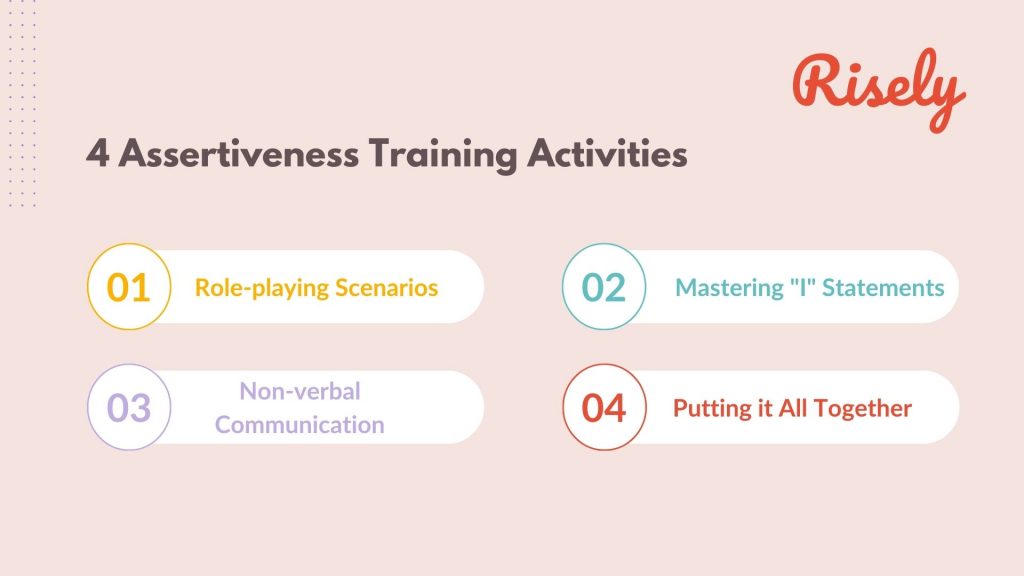Boost Your Confidence and Communication: Top 4 Assertiveness Training Activities
It’s Tuesday morning, and you’re meeting with your team. A colleague proposes an approach you disagree with but hesitates to speak up. Worried about being seen as “pushy” or “difficult,” you hold back your opinion even though you have a valuable alternative. This familiar scenario highlights the importance of assertiveness training activities in the workplace. Assertiveness is not about being aggressive or domineering; it’s about confidently expressing your thoughts, needs, and feelings respectfully and clearly. Strong assertiveness skills are crucial for effective communication, confidence, and career advancement. By learning to speak up and advocate for yourself, you can navigate workplace challenges with resilience and contribute your unique voice to your team and organization.Table of Contents
- Boost Your Confidence and Communication: Top 4 Assertiveness Training Activities
- Defining Assertiveness and Its Role in the Workplace
- Reaping the Rewards: Understanding the Benefits of Assertiveness
- Overview of Assertiveness Training Programs and Techniques
- Why are practical activities crucial in these training sessions?
- Stepping Up Your Game: Engaging Assertiveness Training Activities
- Wrapping Up
Defining Assertiveness and Its Role in the Workplace
Imagine a spectrum of communication styles. At one end, you have passive communication, where individuals shy away from expressing their opinions or needs, often prioritizing the feelings of others over their own. At the opposite end lies aggressive communication, characterized by forceful statements and disregarding the perspectives and feelings of others. Now, picture yourself standing confidently in the middle of this spectrum. This is the ideal space occupied by assertiveness, a healthy and effective communication style for professional settings. So, what exactly is assertiveness? Assertiveness is expressing your thoughts, needs, and feelings clearly, directly, and respectfully. It’s about respecting yourself and others while advocating for your interests professionally and appropriately. Here’s how assertiveness differs from passive and aggressive communication styles: Passive Communication:- Characteristics: Hesitates to express opinions, avoids conflict, prioritizes others’ needs over their own, and uses apologetic language.
- Workplace impact: May be overlooked, undervalued, or taken advantage of.
- Example: “Oh, it’s okay if you don’t need my report finished today. I’m not important.”
- Characteristics: Dominates conversations, interrupts others, uses aggressive and body language, disregards others’ feelings.
- Workplace impact: Can create conflict, damage relationships, and harm team morale.
- Example: “You need to prioritize my task first! Don’t even think about delaying it for anyone else.”
- Characteristics: Expresses opinions clearly and confidently, respects the views of others, uses “I” statements, and uses confident body language.
- Workplace impact: Fosters effective communication, builds trust and respect, and promotes collaboration and problem-solving.
- Example: “I believe this alternative approach could be more efficient. Would you be open to discussing it further?”
Reaping the Rewards: Understanding the Benefits of Assertiveness
In a professional environment, communicating effectively and advocating for your ideas is paramount. While the concept of “speaking up” may seem daunting at first, cultivating strong assertiveness skills unlocks a multitude of benefits for both individual and collective success. Let’s delve into the key advantages of becoming a confident and assertive communicator in the workplace.- Increased Confidence: Assertiveness empowers you to express your opinions and needs clearly without hesitation. This newfound ability to articulate your thoughts and perspectives fosters self-confidence and bolsters your credibility within the team. As you practice and refine your assertiveness, you gain a deeper sense of self-worth and feel more comfortable taking initiative and embracing new challenges.
- Improved Communication: Assertiveness acts as a bridge between respectful communication and expressing your needs. Confidently stating your opinions and concerns encourages open and inclusive dialogue within your team. This fosters a collaborative environment where diverse perspectives are valued and heard, leading to more informed decision-making.
- Career Advancement: In today’s competitive landscape, advocating for yourself is crucial for career advancement. Assertive individuals are seen as reliable, proactive, and capable of owning their work. They are more likely to seek opportunities and negotiate effectively, demonstrating their value and commitment to their professional goals.
Overview of Assertiveness Training Programs and Techniques
In today’s dynamic workplace, navigating effective communication and asserting yourself respectfully can be crucial for success. Recognizing this need, various assertiveness training activities activities and techniques have emerged, offering individuals valuable tools to enhance their communication skills and build confidence. These programs typically:- Provide a foundation for understanding assertiveness: They define and differentiate assertiveness from passive and aggressive communication styles, highlighting the benefits of each style in different situations.
- Develop self-awareness: Through exercises and assessments, participants gain insights into their current communication patterns and identify areas for improvement.
- Equip individuals with practical skills: Key communication techniques such as “I” statements, active listening, and effective feedback delivery are taught and practiced.
- Promote confident and respectful communication: Participants learn to express themselves clearly and directly while respecting others’ perspectives and feelings.
- Offer strategies for handling challenging situations: The program may include specific techniques for dealing with conflict, confidently saying ” no, ” and effectively navigating difficult conversations.
Other Interesting Reads
Why are practical activities crucial in these training sessions?
Mere theoretical knowledge often fails to equip individuals with the confidence and skills to apply assertiveness training activities in real-world scenarios. Incorporating practical activities into training sessions offers numerous benefits:- Improved learning and retention: Engaging exercises allow participants to actively experience and practice the learned concepts, leading to deeper understanding and better material retention.
- Identifying individual challenges and strengths: Through practical activities, participants can identify their specific areas of difficulty and receive personalized feedback to address them.
- Fostering a collaborative learning environment: Engaging activities encourage interaction and collaboration, fostering community and shared learning among participants.

Stepping Up Your Game: Engaging Assertiveness Training Activities
Equipping yourself with the tools of assertiveness is only the first step. To truly master confident communication, practice, and application are key. Here are some engaging activities that can be incorporated into assertiveness training activities sessions to solidify your learning and build your assertiveness muscle: 1. Role-playing Scenarios: This interactive activity allows you to step into real-life workplace situations and practice using assertiveness training activities and techniques. Participants can tackle various scenarios, such as:- Expressing disagreement with a colleague’s proposal in a meeting.
- Asking for constructive feedback from a supervisor.
- Requesting a coworker for additional resources.
- Disagreeing: “This approach might not be the most efficient. Could we explore other options?”
- Making a request: “I believe my workload has become quite heavy. I would appreciate it if we could discuss delegating some tasks.”
- Practicing confident body language: Stand tall, maintain good eye contact, and use open gestures. You can practice in front of a mirror or with a partner.
- Modulating your tone: Avoid monotone speech and use variations in your voice to emphasize key points.
- Dealing with a demanding colleague.
- Setting boundaries with a micromanaging supervisor.
- Saying “no” gracefully to an unreasonable request.

